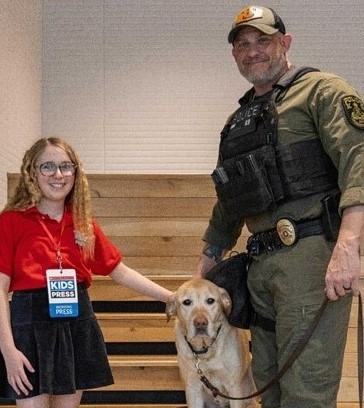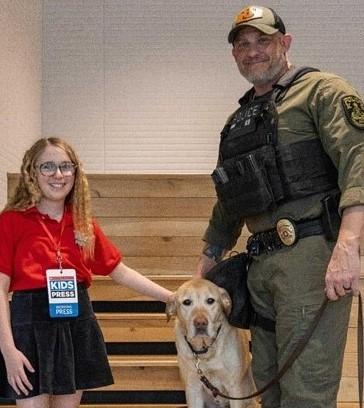KID REPORTERS’ NOTEBOOK
The CIA’s K-9 Unit: A Closer Look at These Dogs’ Vital Role


Coco with K-9 handler and trainer Officer Derek P. and K-9 Beethoven
For many years, the Central Intelligence Agency (CIA) has maintained a specialized team of dogs known as the K-9 unit. These highly trained dogs assist the CIA by identifying threats such as explosives through their exceptional sense of smell. According to scientists, their noses are 10,000 to 100,000 times more sensitive than ours, making them perfect for detecting explosive odors.
Officer Derek P., a K-9 trainer and officer, has been with the CIA since 2001 and began working with the K-9 unit in 2003. His K-9 partner Beethoven, affectionately known as “Beets”, is a 7-year-old yellow Labrador Retriever. Similar to CIA officers, these dogs undergo rigorous training, including timed sniff tests where they must locate a small disc with a bomb odor. These tests are often conducted in dark rooms to simulate real-world conditions. To ensure safety, the K-9s are trained to sit once they have found the disc.
Upon successfully locating the sniffer tin, the dogs are rewarded with food or special dog treats. Initially, toy rewards were used, but trainers discovered that food rewards were more effective as toys could sometimes distract the dogs. Despite this, the dogs still learn fun tricks that can be useful in their work. Beets can shake hands, and Derek’s previous dog could salute. Labrador Retrievers are the most popular breed in the K-9 unit due to their ability to blend in seamlessly.

Coco petting Beethoven during her interview
Beets has earned multiple awards at K-9 competitions, including the U.S. Police Canine Association National Detector Trials, where Beets took first and second place in consecutive years. This competition involves a series of tests where dogs must find narcotics and explosives in various situations. Derek shared, “I've learned that over the past two years it's not about how fast you go; it's about finding the odors and the explosive odors that you're looking for.”
The K-9s are always on duty, and their handlers continue to train them even outside of work hours. The dogs even have their own travel documents to deploy on missions that are similar to passports used by humans.
As part of their training, handlers take them home to integrate them into their families. Derek commented, “[Beets] is a pet when he goes home. I go in the house and he runs around the house with all my other dogs and my kids. He's just another family member.” For health reasons the dogs retire after 8 or 9 years of service. After retirement, they live with their handlers, as it would be difficult to part with them after so many years. The CIA also established the K-9 Wellbeing Program to cover basic costs and support retired dogs.
